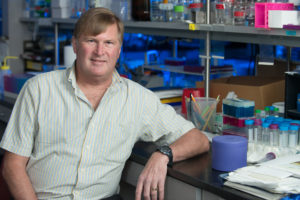A swath of coppery hair sits over John Spencer’s left eye like a shutter protecting a window to somewhere interesting. He shifts in his chair and his blue eyes glisten with memories and the emotion of a life’s work well spent and a desire to keep going.
Spencer spends nearly six months of every year in the Amazon region of Brazil working to end the stigma associated with leprosy and to help those infected understand, manage, and defeat the disease.
A researcher and associate professor of microbiology at Colorado State University, Spencer recently reflected on the 15 years he has spent studying M. leprae, the tiny bacterium that causes leprosy.
He hopes that within 75 years, leprosy cases in the Amazon region will fall from the current five per 10,000 people to less than one. That’s why he does what he does. He believes that with a commitment to whole health — focusing on education, nutrition, sanitation, and improved living conditions — Brazil and the world will see leprosy, and many other tropical diseases, decline and overall health of people improve.
A life-changing lunch
Sometimes the random person you meet at a lunch becomes a research partner and great friend. Spencer met Dr. Claudio Salgado in 2010 at a meeting in Uberlandia, Minas Gerais, Brazil.
What is leprosy?
Leprosy is a disease of the skin and nerves. It is mainly spread through bacteria shed from the nose. It’s slow growing, so symptoms usually take three to seven years to manifest. Leprosy likes tight quarters, big families, and 34 degrees Celsius. It can cause skin lesions, nerve damage, and the loss of skin color. Untreated, it can be debilitating, causing permanent disfigurement and disability and social stigmatization. Detected early and treated, the effects of leprosy can be managed and even reversed.
“We sat beside each other at lunch, and he was this big, jovial guy,” said Spencer. “We started joking and laughing. It was like we were twins separated at birth. He invited me to teach a class.” And that is how Spencer began his leprosy work in the Amazon.
Salgado, who has focused on leprosy since he began his medical training, is a professor and founder of the Laboratory of Dermatology and Immunology at the Federal University of Pará in Belém, Brazil.
“This partnership we’ve built has been fruitful in so many ways,” Salgado said. “I am a clinician and John is a lab guy, so we complement each other. There still are many cases of leprosy in Brazil and we are working to find more answers and more tools that will help people in the poorest parts of the world. I hope we can work together for a long time.”
Research, medical team works in 15 cities

Up until that fateful lunch, Spencer had specialized in basic laboratory research in leprosy and tuberculosis, working exclusively on leprosy since 1999. It didn’t take him long to become invested in his new work that would take him out of the lab and into communities where he could change lives.
Spencer and Salgado accompany a team of nearly two dozen doctors, nurses, and other specialists who spend intense days educating, testing for, and treating leprosy. Salgado’s group works in 15 different cities, including Breves on Marajó Island, the largest island in Brazil. Leprosy is most prevalent in this rural Amazon region.
Spencer is on the ground in schools and homes in rural Brazil, so he understands what leprosy means to the people who have it. He looks into eyes and sees the emotion on faces. He’s there when fathers realize for the first time that they’ve spread leprosy to their families. He’s there when a teenager shyly admits to not taking his medicine when he should because the treatment discolors his skin. He’s there when a child connects disease to the joint stiffness in her arm. He’s there when it all makes sense. He’s there to say, “Don’t be afraid. We can help you.”
When he thinks about the vast number of leprosy cases in the Amazon region of Brazil, Spencer only comes up with the one word: astonishing. “It is astonishing and sad,” he said. “And there’s such a stigma associated with it.”
So, every trip Spencer makes to the rainforest is a chance to heal and a step toward a future without leprosy. Novartis, a major pharmaceutical company, has offered free medicine to patients worldwide since 2000 and will until 2020. Spencer said he suspects that the country will continue to provide free treatment after that time. Brazil has a good program to help people ease back into society once they’ve undergone treatment for leprosy, he said. So he’ll keep working and talking and educating, and he’ll remain hopeful.
“If enough people are interested in this work, and if enough people care and set the wheels in motion, we can increase education,” Spencer said. “We can increase nutrition, improve living conditions and sanitation, and all but end leprosy in rural Brazil because we’ve focused on making life better.”
Learn more about Spencer and Salgado’s collaboration to combat leprosy in this One Health Institute video.
About the One Health Institute at CSU
 The One Health Institute at Colorado State University, under the direction of Bruno Sobral, is a unified campus initiative that is funded through financial support from all eight colleges and the Office of the Vice President for Research. The Institute seeks to work across disciplines, sectors, and professions to help create desired futures. The Institute’s work will benefit health for animals, people, and places by collaborating across boundaries in a way that sees and integrates the whole system. Three foundational principles guide the work: systems thinking, communities creating health, and co-creative design thinking.
The One Health Institute at Colorado State University, under the direction of Bruno Sobral, is a unified campus initiative that is funded through financial support from all eight colleges and the Office of the Vice President for Research. The Institute seeks to work across disciplines, sectors, and professions to help create desired futures. The Institute’s work will benefit health for animals, people, and places by collaborating across boundaries in a way that sees and integrates the whole system. Three foundational principles guide the work: systems thinking, communities creating health, and co-creative design thinking.